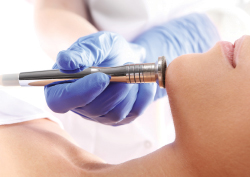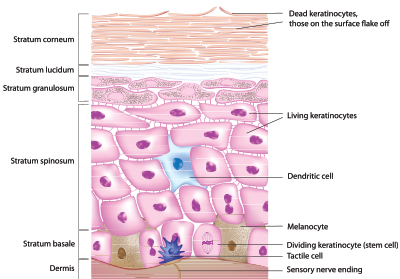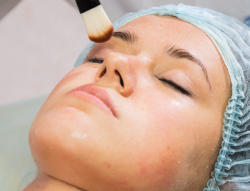Exfoliation simply means the removal of corneocytes on the skin’s epidermis. This complicated immune organ sheds billions of skin cells daily; however, when this natural desquamation slows down or stops due to ultraviolet ray damage, dehydrated or oily skin, winter cold injury, genetics, or skin disorders, the end point is clearly identifiable ensuing in flaky skin, congested pores, and various inflammatory/non-inflammatory acne lesions, resulting in uneven, blotchy, and aged skin.
Exfoliants have been around for centuries and used to rid the epidermis surface of epithelial cell buildup to bring balance back to the skin. This integral exfoliation step in both professional treatments and homecare causes the skin to rid pore toxins, control acne breakouts, remove transient pigmentation, smooth wrinkles, and eliminate the thick, dry corneocyte barrier for better penetration of topicals to replace important indigenous nutrients for a prolific new generation of cell turnover, assembling a younger-acting epidermis. Today, there are many different skin exfoliants for face and body. They range from mechanical to chemical constituents.
 Mechanical exfoliation techniques vary from mesh sponges, gauze, brushes, pumice stones, microfibers, exfoliation sheets, microbead facial scrubs, apricot or almond shells, sugar, salt crystals, corundum, pumice, loofahs, microdermabrasion, or mechanical brushes, just to name a few.
Mechanical exfoliation techniques vary from mesh sponges, gauze, brushes, pumice stones, microfibers, exfoliation sheets, microbead facial scrubs, apricot or almond shells, sugar, salt crystals, corundum, pumice, loofahs, microdermabrasion, or mechanical brushes, just to name a few.
To identify some of the professional chemical exfoliant topicals available, there are salicylic, glycolic, lactic, citric, malic, pyruvic, and trichloroacetic acids, Jessner, enzymes, protease, and
fruit enzymes.
Before application of any chemical desquamation agent, skin care professionals must first understand what these exfoliants accomplish and how the stratum corneum plays an important role for success. All aestheticians should have a comprehensive understanding of the stratum corneum before using exfoliating ingredients on clients. It is, after all, the layer of skin all states in the country use as the measuring stick for our scope of practice in licensing.
THE STRATUM CORNEUM
The stratum corneum is the outermost layer of the skin, the principal barrier tissue preventing water loss, and the final cellular chapter of epidermal differentiation. This mechanism involves a progression of several biochemical processes and the ultimate result is a tissue that prevents transepidermal water loss by the formation of a continuous matrix of highly-organized lipid lamellae, which is embedded into an extensive network of dead cells called corneocytes.
In this perpetual process of cellular activity, keratinocytes divide in the deepest epidermal layers and under normal conditions their proliferation compensates for the loss of cornified cells at the skin’s surface. Right before they desquamate, keratinocytes form a highly-resistant, compact and non-nucleated horny layer.
 Corneocytes
Corneocytes
Corneocyte morphology is crucial to the role of the stratum corneum as a perfunctorily defiant barrier tissue. In the surface area of the skin, layers of corneocytes are tightly and stably-bound to each other to form the stratum corneum, the sheer but tough barrier at the outermost area of the skin directly facing free radical attack of the external environment.
The cells themselves are plate-like, stacked in layers, and the number of which varies throughout the body skin. The corneocytes retain structural characteristics of the parent cell and each corneocyte originates from a keratinocyte, which is actively proliferating in the epidermis under the stratum corneum.
Chemical exfoliants function as a controlled injury to the epidermis by breaking the intercellular corneodesmosomal bonds in the stratum corneum, which encourage desquamation. Removal of these outer corneodesmosomes cell layers compacts the stratum corneum, stimulates epidermal renewal, impacts the dermis that feeds the epidermis, and evens out the distribution of melanin in photo-aged skin.
The epidermis comprises a specialized stratified epithelium containing proliferating keratinocytes in the basal layer that exit the cell cycle, stratify, and migrate through the suprabasal layers, ultimately giving rise to a cornified, dead cell layer in need of exfoliation.
The principal biological mission of the epidermis is to create the stratum corneum to protect the body from the outside world. Cell death awaits these epidermal keratinocytes. This crucial step results in the production of corneocytes. The terminally-differentiated corneocytes shed from the skin surface are continuously replaced from underneath by keratinocytes. There is always a delicate balance between basal cell proliferation and shedding of corneocytes (desquamation) to maintain the constant thickness of the epidermis.
Interestingly, the stratum corneum is consistent tissue comprised of approximately 15 corneocyte non-neucleated layers and is approximately 75 percent of the epidermis volume. Every day, one new generation of a cell layer in the millions replaces the other, 19,500,000 per square inch, materializing in the deeper stratum corneum and the old layer of corneocytes flake off the skin’s exterior. During a lifetime, this shedding phenomena fills an area the size of about six football fields!
Removal of these surface non-nucleated skin cells via exfoliation is central to maintaining skin health and the critical balance of its indigenous inner cellular substances. This is why daily homecare exfoliation and professional treatments are integral to a successful skin care program for anti-aging, acne, pigmentation, rosacea, and maintaining general vigor of the skin. First and foremost, skin care professionals should have knowledge of how the desquamation system functions.
Keratinocytes
Keratinocytes are the main constituent of the epidermis and respond to a variety of inflammatory and immunomodulating cytokines, hormones, vitamins, ultraviolet light, toxins, physical, and controlled chemical injury. In its journey to the top layer of the skin, the keratinocyte goes through several transformations until it can act as a barrier cell.
Skin turnover is a critical factor and plays a major role in the barrier function. Corneocytes result from the differentiation of the keratinocytes from the stratum corneum. The migration from this layer to the surface takes between 12 to 14 days, during which the cells differentiate and begin to die. The lifespan of the corneocytes in the stratum corneum is two to three weeks, as the superficial part of the stratum corneum is continuously desquamated at a balanced rate with the formation of new cells. For desquamation to occur, the cohesive corneodesmosomes binding the corneocytes in the stratum corneum must be degraded by enzymes, such as proteases, which catalyses peptide bonds hydrolysis.
Innercellular residents affect the ultimate outcome of a healthy new skin after exfoliation! Healthy cells replicate healthy cells that ultimately become the stratum corneum. Restoration of barrier function is accompanied by re-accumulation of lipids within the stratum corneum interstices. Restoration requires increased availability of the major lipid components.
Studies clearly demonstrate that epidermal cholesterol, fatty acids, ceramide, and glucosylceramide synthesis are required individually for barrier homeostasis and are removed via exfoliation. After any exfoliation, replacement of the indiginious residents is necessary.
 Ceramides
Ceramides
Ceramides make up the bulk of the lipid layer, which holds the skin’s cells together in a firm, smooth structure. They maintain the moisture-retention ability of the skin and ensure the cohesion of skin cells. A drop in the level of ceramides results in the skin becoming dry and hard, leading, in turn, to fine lines and wrinkles. If the body loses its ability to supply ceramides, the skin loses its structure and texture. Ceramides are used for replenishing the skin’s moisture due to their water binding capacity.
During corneocyte formation, the plasma membrane of viable cells is replaced by a ceramide monolayer, covalently bound to the underlying cornified envelope. This lipid envelope functions as a template for accumulating extra cellular lipid layers. When corneocyte envelopes are removed by any exfoliation modality, these indigenous fluids need replaced. The value of replacing the lipids (natural fats) back to the stratum corneum after organic exfoliation is critical to conserve moisture since water cannot pass through them easily.
In addition, amino acids are removed during any exfoliation process during release of corneocytes and their corneodesmosomes. The major adhesive components of corneodesmosomes are two glycoproteins, desmoglein 1 (DSG 1) and desmocollin 1 (DSC 1), which are expressed in the upper layers of the epidermis. Corneodesmosin (CDSN) is also an adhesive glycoprotein located in the extracellular part of the corneodesmosomes. This glycoprotein is a 529-amino-acid long, glycine- and serine-rich protein. After an exfoliation treatment, an amino acid serum should be applied back into the skin to balance the acid mantle and retain the equilibrium of the stratum corneum.
Restoration of stratum corneum barrier function is accompanied by reaccumulation of lipids within the stratum corneum interstices, which include the amino acids, hylauronic acid, ceramides, and other cell serum identical substances.
In conclusion, professional and home-applied constituents for desquamation and exfoliation is of crucial importance for the maintenance of the function of the stratum corneum for an ageless and healthy skin appearance. A balance between cell shedding at the surface of the epidermis and the proliferation in the basal layer of the epidermis is necessary for the formation of a normal stratum corneum to assure a physiochemical barrier against a hostile environment and prevents water loss of this organism. The desquamation/exfoliation process is a precisely controlled cascade of events. Further study of the stratum corneum and other exfoliation products is ongoing and is expected to give important contributions to this significant area of aesthetic skin biology.
 Licensed as a master aesthetician in Utah and Washington, licensed aesthetician in California and Europe, and in massage therapy, Christine Heathman is an aesthetic pioneer and responsible in the passage of the first master aesthetician license for Utah. Heathman served on the Aesthetician’s Act task force to establish safety guidelines for Utah’s master license and currently serves on the Utah State Board for Cosmetology and Barbering. She is a skin specialist and expert in aging, acne, skin of color, pigmentation, and skin challenged by dermatological, accidental, pre- and post-surgical, and congenital conditions. Heathman has been given many prestigious awards and has appeared on national television programs. She owns GlyMed Plus Professional Only Skin Care.
Licensed as a master aesthetician in Utah and Washington, licensed aesthetician in California and Europe, and in massage therapy, Christine Heathman is an aesthetic pioneer and responsible in the passage of the first master aesthetician license for Utah. Heathman served on the Aesthetician’s Act task force to establish safety guidelines for Utah’s master license and currently serves on the Utah State Board for Cosmetology and Barbering. She is a skin specialist and expert in aging, acne, skin of color, pigmentation, and skin challenged by dermatological, accidental, pre- and post-surgical, and congenital conditions. Heathman has been given many prestigious awards and has appeared on national television programs. She owns GlyMed Plus Professional Only Skin Care.
Want to read more?
Subscribe to one of our monthly plans to continue reading this article.